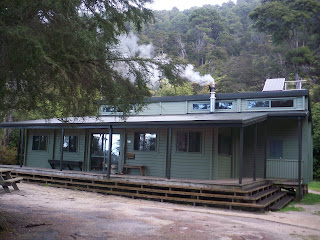Our busy season finished a little after April, and plans were hatched to have a holiday, one month, August 2015.
Leaving Karamea our quiet haven, we enter the realm of Nelson and Golden Bay to explore.
Spent time in Takaka and thought of walking some of the Heaphy Track, this was not to be as snow fall hindered our start.
An alternative plan was hatched. Abel Tasman Track was a better option for a few days of tramping.
Day one from Marahau the start of the trail was a rainy day and got heavier as we soldiered on toward Anchorage Hut for our first night.
Roughly 3 hours slow climb from tidal flats of reeds across a boardwalk, many improvements made since the last time I walked this track. Mostly regenerating forest scrub and well defined track is easy to follow.
Anchorage Hut is recently been rebuilt, with 4 spacious bunk rooms with toilet facilities close and undercover. Large common room and kitchen area, must bring own cooking stove and gas as well as pots.
Day two, has a tidal crossing if you time this well save an hour or so depending on walking speed. if not, a climb back up the ridge you descended the previous day, good views of Torrent Bay and along the coast back to Marahau.
Follow the sign posts carefully as there are a few side trips to the beaches along the way. When you approach Torrent Bay you will see the large orange triangles on poles crossing the estuary, the tidal crossing mentioned earlier.
Today we are heading for Bark Bay about 5 hours walking with breaks to enjoy the landscape and coastal views, much of the time walking in the forest with glimpses of the coastline and reclusive hideaways.
Back Bay Hut is set back from the sea, with a rustic style hut with potbelly stove and a good supply of wood out the back in a shed with an axe, take care when chopping, there is a ranger station close but not always manned.
Day three, an early start as this is the longest day and the most ground to cover as we head to Awaroa Hut. Follow the track and read the signs carefully, a bit of track maintenance is expected as this is a popular walking track for day walkers and trampers.
Many encounters with bird life including a Morepork in the middle of the day, unusual.
Continue until you reach Awaroa Lodge sign indicated to take the right hand track down, but we opted to trek on to the Awaroa Inlet and prepare for the tidal walk to our destination, Awaroa Hut.
A coastal style hut, outlook of the tidal crossing of the Awaroa Inlet toward Totaranui. We are not doing this crossing for this trip.
Day four, an early start to reach the pick up point for our boat trip from the beach at you guess, Awaroa Beach, surprise it is deserted but beautiful, especially at sunrise.
This was a great trail to share and the new improvements make the journey a little easier and memorable. The weather in August for us was wet to start, every day that followed improved so when we water taxied back the sea was perfectly calm.











